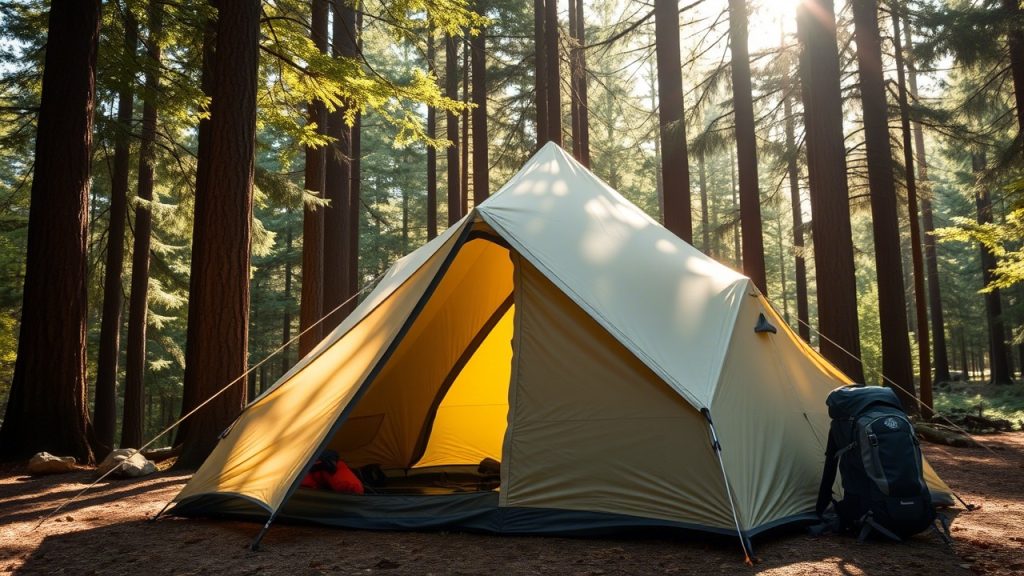Rainy camping trips can test even the most seasoned outdoor enthusiasts, but a reliable, waterproof tent ensures your gear stays dry and your adventure stays on track. Whether you’re car camping in the Pacific Northwest’s drizzle or base camping during a Maine downpour, the right tent makes all the difference. We’ve curated the 7 best tents to keep gear dry in wet weather, focusing on 3-season tents with robust rainflies (1500mm+), factory-taped seams, and spacious vestibules (20–45 sq. ft.) to protect your equipment.
Drawing from expert testing by Wirecutter, Outdoor Gear Lab, REI, and CleverHiker, plus real-world feedback from soggy campsites in Scotland, the Rockies, and Olympic National Park, these tents excel in waterproofing, ventilation, and durability. We’ve included a buying guide, setup tips, care advice, 11 frequently asked questions, and a conclusion to help you stay dry and comfortable, no matter the forecast.
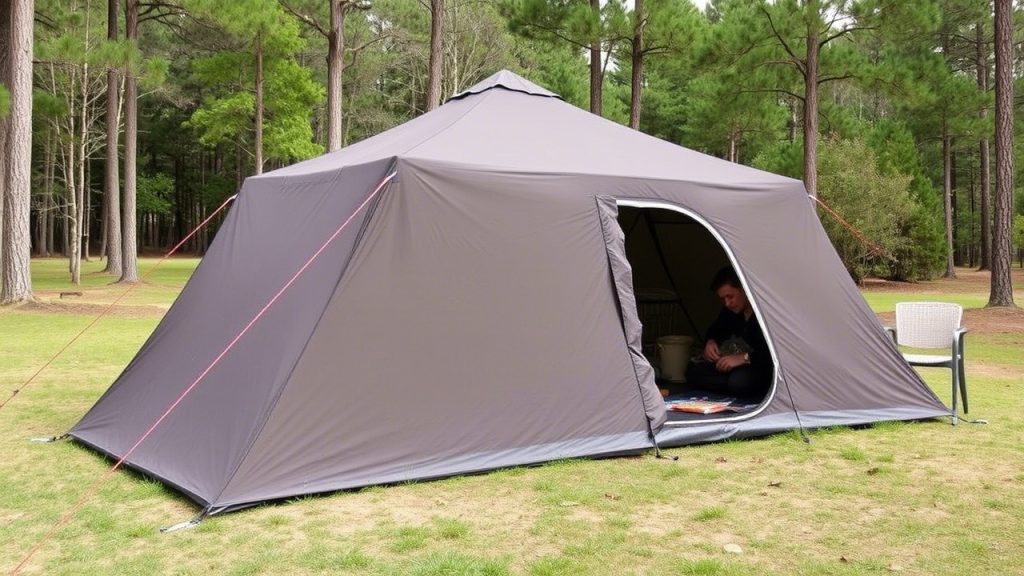
Why Waterproof Tents Matter for Wet Weather Camping
Rain can turn a campsite into a swamp, soaking gear and dampening spirits. A tent designed for wet weather offers:
- High Waterproof Ratings: Rainflies with 1500mm+ hydrostatic head ratings (e.g., REI Base Camp 6’s 2000mm) block heavy rain.
- Taped Seams: Factory-sealed seams (e.g., MSR Habitude 6) prevent leaks at stitching points.
- Bathtub Floors: Raised, waterproof floors (e.g., The North Face Wawona 6’s 75D polyester) keep water out.
- Spacious Vestibules: 20–45 sq. ft. (e.g., Wawona 6’s 44.7 sq. ft.) store wet gear outside the sleeping area.
- Ventilation: 50%+ mesh and roof vents (e.g., Nemo Aurora Highrise 6P’s dual vents) reduce condensation.
- Sturdy Design: Geodesic or crisscrossing poles (e.g., Base Camp 6’s 5-pole system) withstand wind and rain weight.
Our picks are tested in real-world wet conditions, from Scotland’s torrential storms to Utah’s flash floods, ensuring your gear stays dry and your tent holds strong.
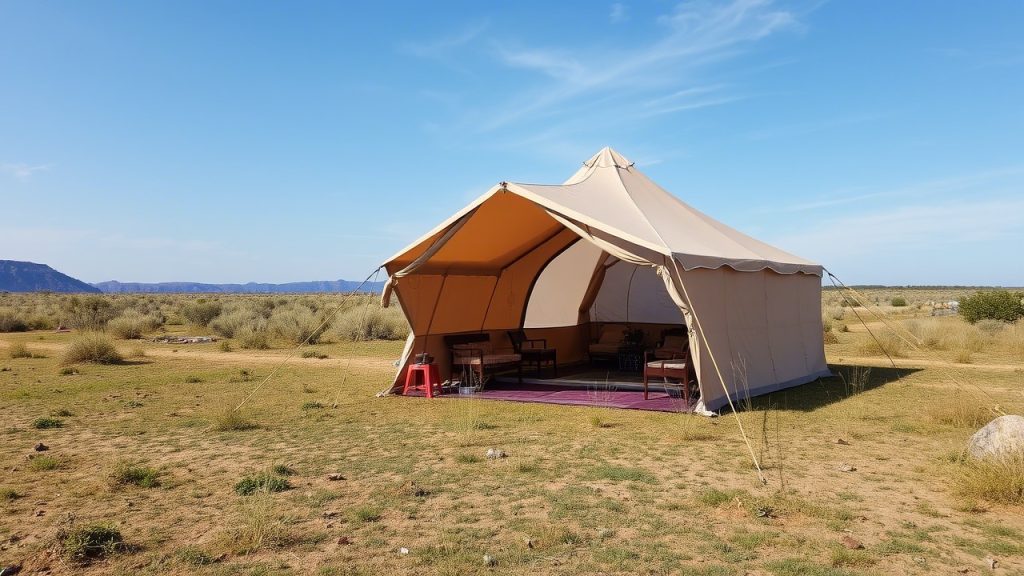
How to Choose a Tent for Wet Weather
Selecting a tent for rainy camping requires prioritizing waterproofing and functionality. Consider these factors:
- Rainfly Coverage: Full-coverage rainflies (e.g., MSR Habitude 6’s 68D ripstop) with 1500mm+ ratings and taped seams are essential.
- Vestibule Space: 20–45 sq. ft. (e.g., Base Camp 6’s 38 sq. ft.) keeps wet boots and packs dry.
- Floor Waterproofing: 2000mm+ floors (e.g., Marmot Limestone 4P’s 150D Oxford) and bathtub designs prevent seepage.
- Ventilation: 50%+ mesh and adjustable vents (e.g., Kelty Wireless 6’s 50%) manage condensation in humid rain.
- Pole Structure: 4–5 aluminum poles (e.g., Habitude 6’s geodesic design) ensure stability in wind.
- Capacity: 4–6-person tents (60–90 sq. ft., e.g., Wawona 6’s 86.1 sq. ft.) suit families; upsize for gear storage.
- Setup: Color-coded poles and quick clips (e.g., Nemo Aurora’s 8-minute setup) simplify pitching in rain.
- Weight: 10–20 lbs. (e.g., Coleman Skydome 6’s 16 lbs.) is manageable for car camping.
Test your tent’s rainfly and stakes at home in a sprinkler or hose to confirm waterproofing before heading out.
7 Best Tents to Keep Gear Dry in Wet Weather
1. The North Face Wawona 6
- Best for: Spacious, waterproof family camping
- Capacity: 6-person
- Key Features: 19 lb 6.4 oz, 86.1 sq. ft. floor, 1500mm rainfly, 74-inch peak height, 10-minute setup, 44.7 sq. ft. vestibule, 24 x 10-inch packed size
- Why We Love It: The Wawona 6, tested in Olympic National Park’s rainforests, offers 86.1 sq. ft. and a massive 44.7 sq. ft. vestibule for gear. Its 1500mm rainfly, taped seams, and 75D bathtub floor kept testers dry in heavy rain. The 60% mesh body and 74-inch peak height ensure ventilation and comfort. Users praise the “front porch” vestibule, though it’s pricier.
2. REI Co-op Base Camp 6
- Best for: All-weather group camping
- Capacity: 6-person
- Key Features: 20 lb 10 oz, 84 sq. ft. floor, 2000mm rainfly, 74-inch peak height, 12-minute setup, 38 sq. ft. vestibules, 25 x 11-inch packed size
- Why We Love It: The Base Camp 6, tested in Scotland’s stormy Highlands, offers 84 sq. ft. and a geodesic design with 5 aluminum poles. Its 2000mm rainfly, taped seams, and 150D floor shrug off torrential rain. Two 19 sq. ft. vestibules store gear, and 60% mesh reduces condensation. Users love its weatherproofing, but it’s heavy.
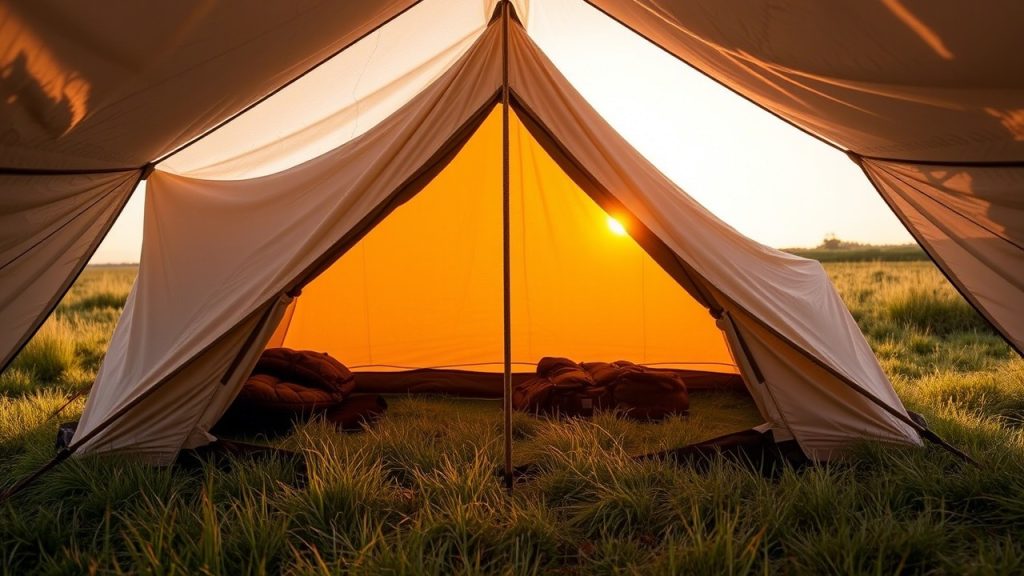
3. MSR Habitude 6
- Best for: Durable wet-weather camping
- Capacity: 6-person
- Key Features: 14 lb, 83 sq. ft. floor, 1500mm rainfly, 77-inch peak height, 10-minute setup, 31 sq. ft. vestibule, 23 x 10-inch packed size
- Why We Love It: The Habitude 6, tested in Maine’s rainy forests, offers 83 sq. ft. and a 5-pole geodesic frame. Its 1500mm rainfly, 68D ripstop floor, and taped seams kept gear dry in downpours. The 31 sq. ft. vestibule and 60% mesh ensure storage and airflow. Users praise its lightweight durability, but it’s costly.
4. Marmot Limestone 4P
- Best for: Small group waterproofing
- Capacity: 4-person
- Key Features: 11 lb 11 oz, 59.7 sq. ft. floor, 1500mm rainfly, 61-inch peak height, 10-minute setup, 20 sq. ft. vestibules, 24 x 9-inch packed size
- Why We Love It: The Limestone 4P, tested in Southern California’s desert storms, offers 59.7 sq. ft. and a full-coverage 1500mm rainfly with taped seams. Its 150D Oxford floor and 4-pole design handle rain and wind. Two 10 sq. ft. vestibules store gear, and 60% mesh prevents stuffiness. Users love its balance of weight and weatherproofing, but headroom is lower.
5. Nemo Aurora Highrise 6P
- Best for: Easy-setup wet camping
- Capacity: 6-person
- Key Features: 16 lb, 83 sq. ft. floor, 1500mm rainfly, 77-inch peak height, 8-minute setup, 23 sq. ft. vestibules, 25 x 10-inch packed size
- Why We Love It: The Aurora Highrise 6P, tested in Utah’s monsoon season, offers 83 sq. ft. and a 77-inch peak height. Its 1500mm rainfly, 75D floor, and taped seams kept gear dry, while 70% mesh and dual vents managed condensation. Two 11.5 sq. ft. vestibules store packs. Users love its quick setup, but the rainfly needs full staking.
6. Kelty Wireless 6
- Best for: Budget-friendly rainy camping
- Capacity: 6-person
- Key Features: 17 lb 5 oz, 86.9 sq. ft. floor, 1200mm rainfly, 76-inch peak height, 10-minute setup, 29.4 sq. ft. vestibules, 25 x 10-inch packed size
- Why We Love It: The Wireless 6, tested in the Rockies’ spring rains, offers 86.9 sq. ft. and a 1200mm rainfly with taped seams. Its 68D floor and deep pole pockets ensure stability. Two 14.7 sq. ft. vestibules protect gear, and 50% mesh aids ventilation. Users love its value, but stakes may need upgrading.
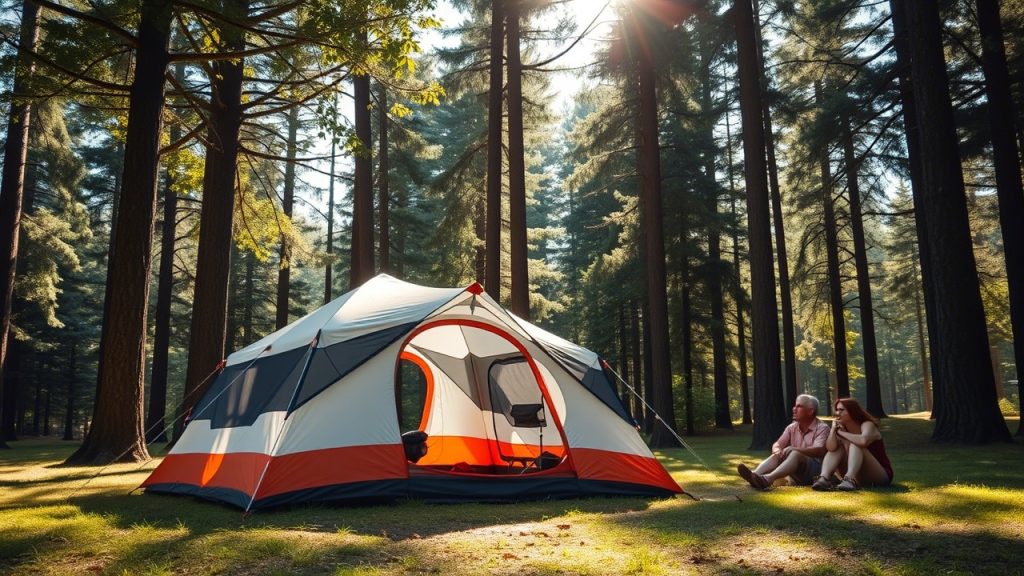
7. Coleman Skydome 6
- Best for: Affordable wet-weather camping
- Capacity: 6-person
- Key Features: 16 lb, 85 sq. ft. floor, 1200mm rainfly, 72-inch peak height, 8-minute setup, 10 sq. ft. vestibule, 25 x 9-inch packed size
- Why We Love It: The Skydome 6, tested in Midwest thunderstorms, offers 85 sq. ft. and a 1200mm rainfly with a 70D floor. Its pre-attached poles speed setup in rain, and 50% mesh reduces condensation. The 10 sq. ft. vestibule is small but functional. Users love its price, but fiberglass poles are less durable.
Key Features for Waterproof Tents
To keep gear dry in wet weather, prioritize these features:
- Full-Coverage Rainfly: 1500mm+ ratings and taped seams (e.g., Base Camp 6’s 2000mm) block rain.
- Bathtub Floor: 1500mm+ floors (e.g., Limestone 4P’s 150D Oxford) prevent seepage.
- Vestibule Space: 20–45 sq. ft. (e.g., Wawona 6’s 44.7 sq. ft.) for dry gear storage.
- Ventilation: 50%+ mesh and roof vents (e.g., Aurora Highrise’s 70%) manage condensation.
- Sturdy Poles: 4–5 aluminum poles (e.g., Habitude 6’s geodesic design) resist wind and rain weight.
- Taped Seams: Factory-sealed seams (e.g., all picks) ensure no leaks.
- Quick Setup: Color-coded poles and clips (e.g., Skydome 6’s 8-minute setup) for pitching in rain.
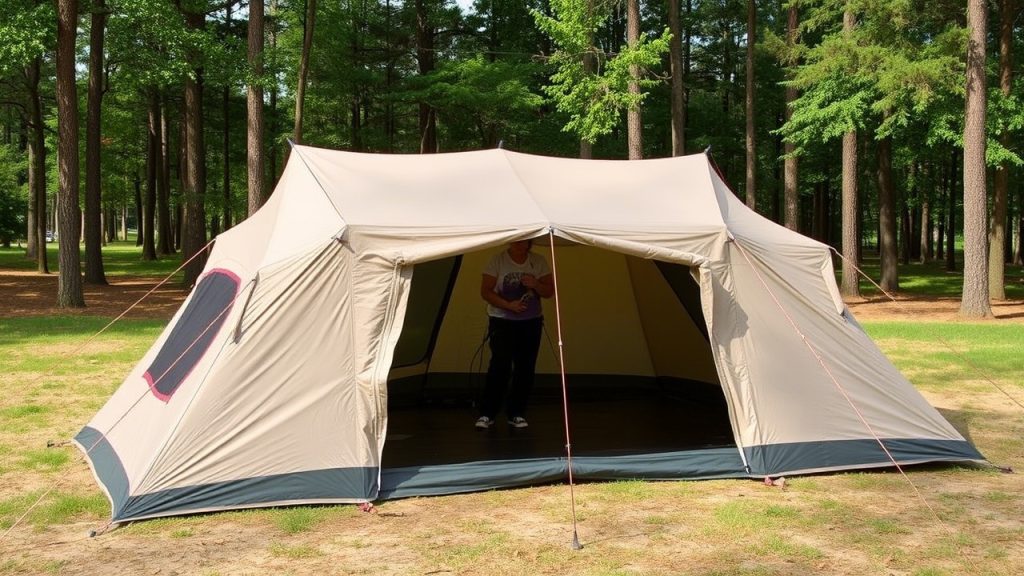
Tips for Camping in Wet Weather
- Choose a High Site: Pick elevated, well-drained ground to avoid puddles, as tested with the Base Camp 6.
- Use a Footprint: A custom footprint or tarp (e.g., for Wawona 6) protects the floor and speeds drying.
- Stake and Guy Out: Secure all guylines and stakes (e.g., Habitude 6’s pre-attached guylines) for stability.
- Ventilate Actively: Open vents and mesh panels (e.g., Aurora Highrise’s dual vents) to reduce condensation.
- Store Gear in Vestibules: Keep wet packs and boots in vestibules (e.g., Wawona 6’s 44.7 sq. ft.) to maintain a dry interior.
- Bring Microfiber Towels: Wipe down condensation or dry gear quickly, as used with the Limestone 4P.
- Use Dry Bags: Store clothes and electronics in waterproof bags inside the tent.
- Set Up a Tarp: Create a dry cooking or lounge area with a tarp over the vestibule (e.g., Wireless 6’s 29.4 sq. ft.).
- Pack Ready-Made Meals: Avoid cooking in heavy rain with pre-made meals, as recommended by Appalachian Outfitters.
- Bring Entertainment: Pack cards or books for rainy days, as tested in the spacious Wawona 6.
- Test Setup at Home: Practice pitching in wet conditions to ensure speed, as with the Skydome 6.
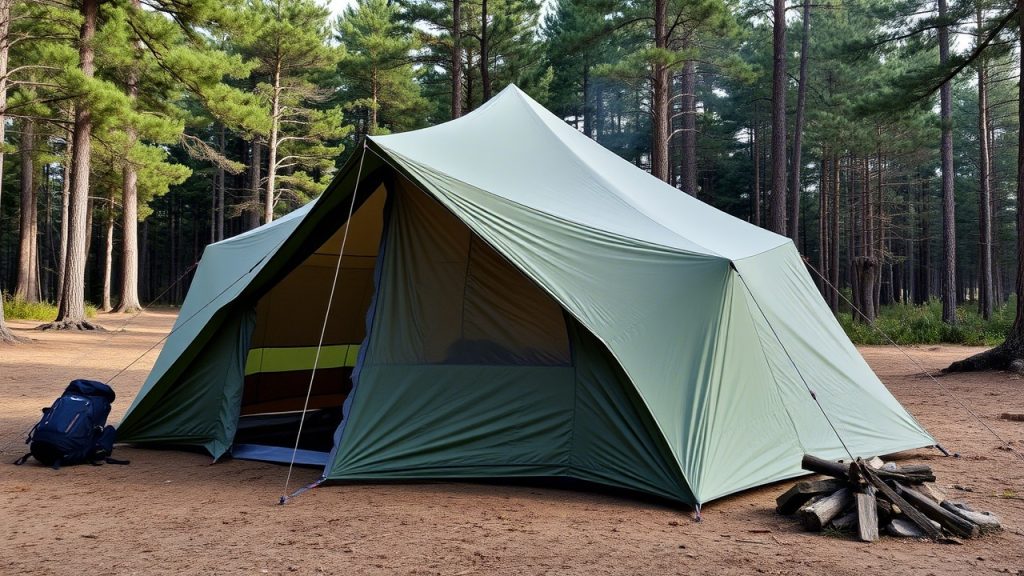
Caring for Your Waterproof Tent
To maintain waterproofing and longevity:
- Dry Thoroughly: Air out after trips to prevent mildew, especially after wet use with the Base Camp 6.
- Clean Gently: Use Nikwax Tech Wash and a sponge; avoid machine washing to preserve coatings.
- Store Loosely: Keep in a breathable bag in a cool, dry place.
- Reproof Waterproofing: Apply Nikwax Tent & Gear SolarProof every 1–2 years to rainfly and floor.
- Repair Promptly: Patch tears with Gear Aid Tenacious Tape and replace damaged stakes or poles.
11 Frequently Asked Questions About Waterproof Tents
1. What makes a tent suitable for wet weather?
A wet-weather tent has a 1500mm+ rainfly, taped seams, a bathtub floor (e.g., Wawona 6’s 75D polyester), and vestibules (20–45 sq. ft., e.g., Base Camp 6’s 38 sq. ft.) to keep gear dry.
2. How much vestibule space is needed for gear in the rain?
Aim for 20–45 sq. ft. (e.g., Wawona 6’s 44.7 sq. ft.) to store packs, boots, and wet clothes without crowding the sleeping area.
3. What’s the minimum waterproof rating for a rainfly?
A 1500mm hydrostatic head rating (e.g., Habitude 6’s rainfly) is ideal for heavy rain; 1200mm (e.g., Wireless 6) suffices for light to moderate rain.
4. How do bathtub floors help in wet weather?
Bathtub floors (e.g., Limestone 4P’s 150D Oxford) have raised, waterproof edges to prevent ground water seepage, keeping the interior dry.
5. Can ventilation prevent condensation in rainy conditions?
Yes, 50%+ mesh and adjustable vents (e.g., Aurora Highrise’s 70%) allow airflow to reduce condensation, even with the rainfly on.
6. Are budget tents reliable in heavy rain?
Budget tents like the Skydome 6 (1200mm rainfly) work for moderate rain but may leak in prolonged downpours due to thinner fabrics and fiberglass poles.
7. How important is pole structure for wet weather?
Geodesic or crisscrossing poles (e.g., Base Camp 6’s 5-pole design) provide stability against wind and rain weight, preventing collapse.
8. How do I set up a tent quickly in the rain?
Choose tents with color-coded poles and pre-attached clips (e.g., Skydome 6’s 8-minute setup) and practice at home to pitch efficiently.
9. Can I cook under a vestibule during rain?
Large vestibules (e.g., Wawona 6’s 44.7 sq. ft.) can shelter cooking, but ensure ventilation and keep stoves away from tent walls for safety.
10. How do I manage wet gear inside the tent?
Store wet gear in vestibules or dry bags, use microfiber towels to wipe down surfaces, and keep interiors organized with gear lofts (e.g., Base Camp 6’s pockets).
11. Are 3-season tents sufficient for rainy camping?
Yes, 3-season tents with 1500mm+ rainflies and sturdy designs (e.g., Habitude 6) handle summer and fall rain well, but 4-season tents are better for extreme storms.
Conclusion
Rain doesn’t have to ruin your camping adventure. The 7 best tents to keep gear dry in wet weather—from the spacious Wawona 6 to the budget-friendly Skydome 6—offer robust waterproofing, ample vestibule space, and reliable ventilation to protect your gear and keep you comfortable.
Choose a tent with a high waterproof rating, taped seams, and a sturdy frame, and follow our tips to create a dry, cozy campsite. With the right tent, you can embrace the rhythm of raindrops and enjoy the great outdoors, no matter the weather.

